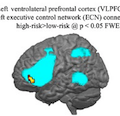Abstract
Objectives: Bipolar disorder (BD) has been associated withdysfunctional brain connectivity and with family chaos. It is not knownwhether aberrant connectivity occurs before illness onset, representingvulnerability for developing BD amidst family chaos. We used resting-state functional magnetic resonance imaging (fMRI) to examine neuralnetwork dysfunction in healthy offspring living with parents with BDand healthy comparison youth.
Methods: Using two complementary methodologies [data-drivenindependent component analysis (ICA) and hypothesis-driven region-of-interest (ROI)-based intrinsic connectivity], we examined resting-statefMRI data in 8–17-year-old healthy offspring of a parent with BD(n = 24; high risk) and age-matched healthy youth without any personalor family psychopathology (n = 25; low risk).
Results: ICA revealed that, relative to low-risk youth, high-risk youthshowed increased connectivity in the ventrolateral prefrontal cortex(VLPFC) subregion of the left executive control network (ECN), whichincludes frontoparietal regions important for emotion regulation.ROI-based analyses revealed that high-risk versus low-risk youth haddecreased connectivities between the left amygdala and pregenualcingulate, between the subgenual cingulate and supplementary motorcortex, and between the left VLPFC and left caudate. High-risk youthshowed stronger connections in the VLPFC with age and higherfunctioning, which may be neuroprotective, and weaker connectionsbetween the left VLPFC and caudate with more family chaos, suggestingan environmental influence on frontostriatal connectivity.
Conclusions: Healthy offspring of parents with BD show atypicalpatterns of prefrontal and subcortical intrinsic connectivity that may beearly markers of resilience to or vulnerability for developing BD.Longitudinal studies are needed to determine whether these patternspredict outcomes.
